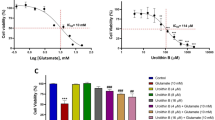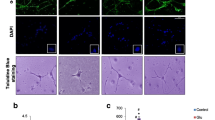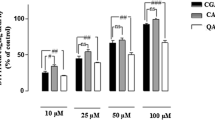Abstract
Glutamate, one of the major neurotransmitters in the central nervous system, is released into the synaptic spaces and bound to the glutamate receptors which facilitate normal synaptic transmission, synaptic plasticity, and brain development. Past studies have shown that glutamate with high concentration is a potent neurotoxin capable of destroying neurons through many signal pathways. In this research, our main purpose was to determine whether the specific soluble guanylyl cyclase activator YC-1 (3-(5′-hydroxymethyl-2′-furyl)-1-benzyl indazole) had effect on glutamate-induced apoptosis in cultured PC12 cells. The differentiated PC12 cells impaired by glutamate were used as the cell model of excitability, and were exposed to YC-1 or/and ODQ (1H-[1,2,4]oxadiazolo[4,3-a]quinoxalin-1-one) with gradient concentrations for 24 h. MTT (3-(4,5-dimethylthiazol-2-yl)-2,5-diphenyl) assay was used to detect the cellular viability. Radioimmunoassay (RIA) was used to detect the cGMP (cyclic guanosine monophosphate) concentrations in PC12 cells. Hoechst 33258 staining and flow cytometric analysis were used to detect the cell apoptosis. The cellular viability was decreased and the apoptotic rate was increased when PC12 cells were treated with glutamate. Cells treated with YC-1 or/and ODQ showed no significant differences in the cell viability and intracellular cGMP levels compared with those of control group. The specific soluble guanylyl cyclase (sGC) inhibitor ODQ showed an inhibitory effect on cGMP level and aggravated the apoptosis of PC12 cells induced by glutamate. YC-1 elevated cGMP level thus decreased PC12 cell apoptosis induced by glutamate, but this effect could be reversed by ODQ. These results revealed that YC-1 might attenuate glutamate-induced PC12 cell apoptosis via a sGC–cGMP involved pathway.







Similar content being viewed by others
References
Ankarcrona M, Dypbukt JM, Orrenius S, Nicotera P (1996) Calcineurin and mitochondrial function in glutamate-induced neuronal cell death. FEBS Lett 394:321–324
Bleich S, Romer K, Wiltfang J, Kornhuber J (2003) Glutamate and the glutamate receptor system: a target for drug action. Int J Geriatr Psychiatry 18:S33–S40
Bredt DS (2003) Nitric oxide signaling in brain: potentiating the gain with YC-1. Mol Pharmacol 63:1206–1208
Cary SPL, Winger JA, Marletta MA (2005) Tonic and acute nitric oxide signaling through soluble guanylate cyclase is mediated by nonheme nitric oxide, ATP, and GTP. P Natl Acad Sci USA 102:13064–13069
Cary SPL, Winger JA, Derbyshire ER, Marletta MA (2006) Nitric oxide signaling: no longer simply on or off. Trends Biochem Sci 31:231–239
Chien WL, Liang KC, Teng CM, Kuo SC, Lee FY, Fu WM (2005) Enhancement of learning behaviour by a potent nitric oxide-guanylate cyclase activator YC-1. Eur J Neurosci 21:1679–1688
Chien WL, Liang KC, Fu WM (2008) Enhancement of active shuttle avoidance response by the NO-cGMP-PKG activator YC-1. Eur J Pharmacol 590:233–240
Choi DW, Rothman SM (1990) The role of glutamate neurotoxicity in hypoxic-ischemic neuronal death. Annu Rev Neurosci 13:171–182
Chun YS, Yeo EJ, Choi E, Teng CM, Bae JM, Kim MS, Park JW (2001) Inhibitory effect of YC-1 on the hypoxic induction of erythropoietin and vascular endothelial growth factor in Hep3B cells. Biochem Pharmacol 61:947–954
Conn PJ (2003) Physiological roles and therapeutic potential of metabotropic glutamate receptors. Ann N Y Acad Sci 1003:12–21
Coyle JT, Puttfarcken P (1993) Oxidative stress, glutamate, and neurodegenerative disorders. Science 262:689–695
Dawson VL, Kizushi VM, Huang PL, Snyder SH, Dawson TM (1996) Resistance to neurotoxicity in cortical cultures from neuronal nitric oxide synthase-deficient mice. J Neurosci 16:2479–2487
Denizot F, Lang R (1986) Rapid colorimetric assay for cell growth and survival. Modifications to the tetrazolium dye procedure giving improved sensitivity and reliability. J Immunol Methods 89:271–277
Derbyshire ER, Marletta MA (2009) Biochemistry of soluble guanylate cyclase. Handb Exp Pharmacol:17-31
Estevez AG, Spear N, Thompson JA, Cornwell TL, Radi R, Barbeito L, Beckman JS (1998) Nitric oxide-dependent production of cGMP supports the survival of rat embryonic motor neurons cultured with brain-derived neurotrophic factor. J Neurosci 18:3708–3714
Farinelli SE, Park DS, Greene LA (1996) Nitric oxide delays the death of trophic factor-deprived PC12 cells and sympathetic neurons by a cGMP-mediated mechanism. J Neurosci 16:2325–2334
Fiscus RR (1988) Molecular mechanisms of endothelium-mediated vasodilation. Semin Thromb Hemost 14 Suppl:12–22
Fiscus RR, Robles BT, Waldman SA, Murad F (1987) Atrial natriuretic factors stimulate accumulation and efflux of cyclic GMP in C6-2B rat glioma and PC12 rat pheochromocytoma cell cultures. J Neurochem 48:522–528
Fiscus RR, Tu AW, Chew SB (2001) Natriuretic peptides inhibit apoptosis and prolong the survival of serum-deprived PC12 cells. Neuroreport 12:185–189
Flamigni F, Facchini A, Stanic I, Tantini B, Bonavita F, Stefanelli C (2001) Control of survival of proliferating L1210 cells by soluble guanylate cyclase and p44/42 mitogen-activated protein kinase modulators. Biochem Pharmacol 62:319–328
Floyd RA, Hensley K (2002) Oxidative stress in brain aging. Implications for therapeutics of neurodegenerative diseases. Neurobiol Aging 23:795–807
Friebe A, Schultz G, Koesling D (1996) Sensitizing soluble guanylyl cyclase to become a highly CO-sensitive enzyme. EMBO J 15:6863–6868
Froissard P, Duval D (1994) Cytotoxic effects of glutamic acid on PC12 cells. Neurochem Int 24:485–493
Funasaka T, Yanagawa T, Hogan V, Raz A (2005) Regulation of phosphoglucose isomerase/autocrine motility factor expression by hypoxia. FASEB J 19:1422–1430
Garthwaite G, Garthwaite J (1988) Cyclic GMP and cell death in rat cerebellar slices. Neuroscience 26:321–326
Garthwaite G, Goodwin DA, Neale S, Riddall D, Garthwaite J (2002) Soluble guanylyl cyclase activator YC-1 protects white matter axons from nitric oxide toxicity and metabolic stress, probably through Na(+) channel inhibition. Mol Pharmacol 61:97–104
Gerstner B, Lee J, DeSilva TM, Jensen FE, Volpe JJ, Rosenberg PA (2009) 17beta-estradiol protects against hypoxic/ischemic white matter damage in the neonatal rat brain. J Neurosci Res 87:2078–2086
Greene LA (1978) Nerve growth factor prevents the death and stimulates the neuronal differentiation of clonal PC12 pheochromocytoma cells in serum-free medium. J Cell Biol 78:747–755
Hoenicka M, Becker EM, Apeler H, Sirichoke T, Schroder H, Gerzer R, Stasch JP (1999) Purified soluble guanylyl cyclase expressed in a baculovirus/Sf9 system: stimulation by YC-1, nitric oxide, and carbon monoxide. J Mol Med 77:14–23
Hsieh GC, O’Neill AB, Moreland RB, Sullivan JP, Brioni JD (2003) YC-1 potentiates the nitric oxide/cyclic GMP pathway in corpus cavernosum and facilitates penile erection in rats. Eur J Pharmacol 458:183–189
Ibrahim M, Derbyshire ER, Soldatova AV, Marletta MA, Spiro TG (2010) Soluble Guanylate Cyclase Is Activated Differently by Excess NO and by YC-1: Resonance Raman Spectroscopic Evidence. Biochemistry-Us 49:4864–4871
Ishima T, Nishimura T, Iyo M, Hashimoto K (2008) Potentiation of nerve growth factor-induced neurite outgrowth in PC12 cells by donepezil: role of sigma-1 receptors and IP3 receptors. Prog Neuropsychopharmacol Biol Psychiatry 32:1656–1659
Kim YM, Chung HT, Kim SS, Han JA, Yoo YM, Kim KM, Lee GH, Yun HY, Green A, Li J, Simmons RL, Billiar TR (1999) Nitric oxide protects PC12 cells from serum deprivation-induced apoptosis by cGMP-dependent inhibition of caspase signaling. J Neurosci 19:6740–6747
Kuribayashi K, Kitaoka Y, Kumai T, Munemasa Y, Isenoumi K, Motoki M, Kogo J, Hayashi Y, Kobayashi S, Ueno S (2006) Neuroprotective effect of atrial natriuretic peptide against NMDA-induced neurotoxicity in the rat retina. Brain Res 1071:34–41
Lipton SA, Rosenberg PA (1994) Excitatory amino acids as a final common pathway for neurologic disorders. N Engl J Med 330:613–622
Miller LN, Nakane M, Hsieh GC, Chang R, Kolasa T, Moreland RB, Brioni JD (2003) A-350619: a novel activator of soluble guanylyl cyclase. Life Sci 72:1015–1025
Mulsch A, Bauersachs J, Schafer A, Stasch JP, Kast R, Busse R (1997) Effect of YC-1, an NO-independent, superoxide-sensitive stimulator of soluble guanylyl cyclase, on smooth muscle responsiveness to nitrovasodilators. Br J Pharmacol 120:681–689
Ndountse LT, Chan HM (2009) Role of N-methyl-D-aspartate receptors in polychlorinated biphenyl mediated neurotoxicity. Toxicol Lett 184:50–55
Pan SL, Guh JH, Chang YL, Kuo SC, Lee FY, Teng CM (2004) YC-1 prevents sodium nitroprusside-mediated apoptosis in vascular smooth muscle cells. Cardiovasc Res 61:152–158
Pan SL, Guh JH, Peng CY, Wang SW, Chang YL, Cheng FC, Chang JH, Kuo SC, Lee FY, Teng CM (2005) YC-1[3-(5′-hydroxymethyl-2′-furyl)-1-benzyl indazole] inhibits endothelial cell functions induced by angiogenic factors in vitro and angiogenesis in vivo models. J Pharmacol Exp Ther 314:35–42
Parathath SR, Gravanis I, Tsirka SE (2007) Nitric oxide synthase isoforms undertake unique roles during excitotoxicity. Stroke 38:1938–1945
Rukenstein A, Rydel RE, Greene LA (1991) Multiple agents rescue PC12 cells from serum-free cell death by translation- and transcription-independent mechanisms. J Neurosci 11:2552–2563
Stasch JP, Hobbs AJ (2009) NO-independent, haem-dependent soluble guanylate cyclase stimulators. Handb Exp Pharmacol 191:277–308
Stasch JP, Becker EM, Alonso-Alija C, Apeler H, Dembowsky K, Feurer A, Gerzer R, Minuth T, Perzborn E, Pleiss U, Schroder H, Schroeder W, Stahl E, Steinke W, Straub A, Schramm M (2001) NO-independent regulatory site on soluble guanylate cyclase. Nature 410:212–215
Thippeswamy T, Morris R (1997) Cyclic guanosine 3′,5′-monophosphate-mediated neuroprotection by nitric oxide in dissociated cultures of rat dorsal root ganglion neurones. Brain Res 774:116–122
Urushitani M, Nakamizo T, Inoue R, Sawada H, Kihara T, Honda K, Akaike A, Shimohama S (2001) N-methyl-d-aspartate receptor-mediated mitochondrial Ca(2+) overload in acute excitotoxic motor neuron death: a mechanism distinct from chronic neurotoxicity after Ca(2+) influx. J Neurosci Res 63:377–387
Vanhoutte PM (1997) Endothelial dysfunction and atherosclerosis. Eur Heart J 18 (Suppl E):E19–29
Wu CC, Ko FN, Kuo SC, Lee FY, Teng CM (1995) YC-1 inhibited human platelet aggregation through NO-independent activation of soluble guanylate cyclase. Br J Pharmacol 116:1973–1978
Wu CH, Chang WC, Chang GY, Kuo SC, Teng CM (2004) The inhibitory mechanism of YC-1, a benzyl indazole, on smooth muscle cell proliferation: an in vitro and in vivo study. J Pharmacol Sci 94:252–260
Yeo EJ, Chun YS, Cho YS, Kim J, Lee JC, Kim MS, Park JW (2003) YC-1: a potential anticancer drug targeting hypoxia-inducible factor 1. J Natl Cancer Inst 95:516–525
Acknowledgments
This work was partly supported by 100 projects of Nankai university for undergraduates, Tianjin research program of application foundation and advanced technology (10JCZDJC19100) and the national natural science foundation of China (31000509).
Author information
Authors and Affiliations
Corresponding author
Rights and permissions
About this article
Cite this article
Yang, X., Wang, Y., Luo, J. et al. Protective Effects of YC-1 Against Glutamate Induced PC12 Cell Apoptosis. Cell Mol Neurobiol 31, 303–311 (2011). https://doi.org/10.1007/s10571-010-9622-9
Received:
Accepted:
Published:
Issue Date:
DOI: https://doi.org/10.1007/s10571-010-9622-9




